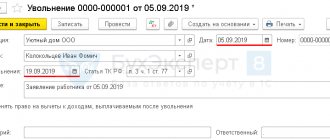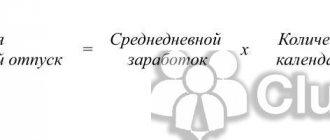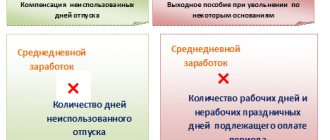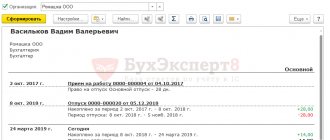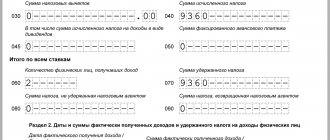What does severance compensation mean?
When talking about compensation for leave upon dismissal, we usually mean its most general case, which applies to absolutely all employees.
This is compensation upon dismissal in the form of vacation pay due for vacation not used during the period of work. Every employee has the right to annual paid leave, and at the time of dismissal, part of it (and sometimes even several years of leave) may be unused. Art. 127 of the Labor Code of the Russian Federation obliges to pay this part in case of dismissal, no matter what its actual duration turns out to be. The reason for termination of the employment contract does not matter when calculating compensation upon dismissal. How to calculate days of compensation upon dismissal? The duration of standard annual leave is 28 calendar days (Article 115 of the Tax Code of the Russian Federation). However, for some categories of workers it is extended (Articles 116–119, Article 348.10 of the Labor Code of the Russian Federation). Vacation pay upon dismissal is calculated based on the length of vacation that is due to a particular person, taking into account the extension, if any. Holidays do not include holidays.
The beginning of the year to which the annual leave will relate is determined individually by each employer for each specific employee - from the first day of his employment for this job (clause 1 of the Rules on regular and additional leaves, approved by the People's Commissar of the USSR on April 30, 1930 No. 169), and the end may be shifted if, during the calendar year calculated from the starting date, the employee experienced periods that were not included in this length of service (Article 121 of the Labor Code of the Russian Federation).
Calculation of compensation for dismissal in 2021 is also carried out for persons signed under a fixed-term (up to 2 months) employment contract (Article 291 of the Labor Code of the Russian Federation) or for part-time work (Article 93 of the Labor Code of the Russian Federation). For a fixed-term contract, vacation pay is calculated based on the fact that each month worked corresponds to 2 working days of vacation.
There is no need to accrue compensation for unused vacation upon dismissal to employees:
- drawn up under a GPC agreement (Article 11 of the Labor Code of the Russian Federation);
- those who worked less than half a month (clause 35 of the Rules on regular and additional leaves, approved by the People's Commissariat of Labor of the USSR on April 30, 1930 No. 169).
The accrued compensation upon dismissal is subject to insurance premiums, personal income tax and is paid along with other amounts due to the employee on the last day of his work activity (Article 140 of the Labor Code of the Russian Federation).
ConsultantPlus experts have made an analytical selection on legal disputes with employees regarding the payment of dismissal compensation. Get trial access to the system and find out court decisions on the most common questions.
Read about whether it is possible to receive vacation pay compensation without resorting to dismissal.
Procedure for calculating compensation
When mentioning the procedure for calculating compensation for vacation days, it is assumed that the total number of days for which it is necessary to provide payment to the employee is determined, as well as the determination of his earnings received per day. To understand the calculation procedure, it is necessary to dwell on each of these concepts separately.
Average earnings
This is the average amount of income provided to an employee that was paid to that particular employee during a certain period of time. This indicator is very important and should be used not only when calculating the amount of the benefit due, but also, in particular, to determine the exact amount of transferred pension accruals.
Average earnings can be calculated if there are accruals:
- according to the tariff;
- according to salary;
- according to the deal.
It is worth noting separately that all payments that are not subject to income tax are not subject to participation in the calculation. This includes the following types of payments:
- funds received for sick leave;
- vacation pay provided;
- various financial assistance;
- benefits provided by the organization.
To calculate the total number of unused vacation days, just remember the rules of simple mathematics. If an employee is entitled to twenty-eight calendar vacation days for the full twelve months worked, then calculating the unused amount will not be difficult.
However, it is worth noting some peculiarities of such calculations:
- if an employee worked less than fifteen days in a month, this month is not taken into account in the calculation;
- if, accordingly, the employee worked more than fifteen days, the month is rounded up to the full month.
It is carried out by calculating the average salary for the last calendar year and the average daily earnings, which is determined by the formula: Average daily earnings = OT annual: 12:29.3
Accordingly, in order to calculate the due compensation for unused vacation days, it is necessary to calculate the amount of average earnings received per day and multiply it by the number of days remaining from the total rest time.
Formula for calculating compensation in 2021
How to correctly calculate vacation compensation upon dismissal? In 2021, a formula is used for this, according to which the amount of compensation upon dismissal is equal to:
KNO = SDZ × NDO,
Where:
KNO - compensation for vacation upon dismissal, if the vacation was not used;
SDZ - average daily earnings;
NDO - the number of unused vacation days.
When calculating compensation upon dismissal, the amount of average daily earnings Art. 139 of the Labor Code of the Russian Federation prescribes to determine it as follows:
SDZ = WIP / 12 / 29.3,
Where:
WIP - wages accrued for the estimated period of time (12 months before the month of dismissal);
12 - number of months in the billing period;
29.3 - the average number of calendar days per 1 month of the billing period.
However, not all income paid by the employer and, accordingly, not all periods during which the employee works for the employer can be taken into account when determining the average daily earnings (clause 5 of the Government of the Russian Federation Resolution No. 922 dated December 24, 2007). In particular, it does not include accruals for periods of vacations, sick leave, and business trips.
In this case, the working time taken into account to calculate the average daily earnings will be the sum of the number of days corresponding to months worked in full, the number of days in each of which will be taken as 29.3, and the amount of calendar days of work for incomplete months (clause 10 resolution No. 922).
The procedure for accounting for bonuses related to wages in the calculation depends on the period for which they are paid (clause 15 of Resolution No. 922).
For more information on how to take bonuses into account when calculating compensation, read the article “Are bonuses taken into account when calculating vacation pay?”
In addition, with regard to income for the billing period (12 months), the following situations are possible:
- The income occurred only in the month of dismissal. Then the average daily earnings will be calculated for this month alone, dividing the salary accrued in it by the average number of calendar days calculated for this month (clause 7 of Resolution No. 922). The last value will be calculated from the number 29.3 in proportion to the share of calendar days corresponding to the time of work in the month of dismissal in the total number of days in the same month (clause 10 of Resolution No. 922).
- There was no income in the billing period. Then the period for calculating the average daily earnings is shifted to the previous period of the same duration (clause 6 of Resolution No. 922). And if there is no income there, then the average daily earnings will be calculated from the salary or tariff rate (clause 8 of Resolution No. 922).
For more information about calculating vacation pay in the absence of income in the billing period, read the material “Calculating the number of vacation days in 2021 - 2021 - an example.”
Example of calculating severance pay
Incoming data:
- employee Ivanov V.K. salary accrued for the previous year - 253,800 rubles;
- total working days in the period - 247 days;
- the number of working days during the vacation period is 20 days.
We calculate the average daily earnings:
247 - 20 = 227 - days worked
253,800 / 227 = 1,118.06 rubles. - average daily earnings
We calculate benefits for 3 months:
1,118.06 * 20 days = 22,361.20 rub. — severance pay for 1 month
1,118.06 * 21 days = 23,479.26 rub. - average monthly earnings for 2 months
1,118.06 * 22 days = 25,597.32 rub. - average monthly earnings for 3 months
Severance pay and average monthly earnings are not subject to personal income tax, since they relate to compensation payments. However, this rule applies only if payments do not exceed 3 times the average monthly salary (for regions of the Far North, 6 times the average monthly salary). Otherwise, personal income tax must be withheld and transferred from the excess amount.
Insurance contributions for severance pay and average monthly earnings are calculated in the same manner as when calculating personal income tax, that is, taking into account the limit established by law.
Important! Although compensation for leave upon dismissal is called compensation, personal income tax must be withheld from it, as well as insurance premiums must be charged.
Leave compensation upon dismissal: calculation
The number of days of unused vacation is determined based on the fact that a full year of experience giving the right to it corresponds to 28 calendar days, and each full month corresponds to 2.33 calendar days. When the last month of service turns out to be incomplete, then, when calculating compensation upon dismissal, it is taken into account as full if the number of days of work in it exceeds half a month, and is not taken into account when the period worked in it is less than half a month (clause 35 of the Rules on regular and additional holidays approved by the USSR People's Commissariat of Labor on April 30, 1930 No. 169).
There are situations in which it becomes mandatory to pay compensation for leave upon dismissal for a full year, although in reality it turns out to be not fully worked out (clause 28 of the Rules on regular and additional leaves, approved by the People's Commissariat of Labor of the USSR on April 30, 1930 No. 169). These are cases when the employee worked:
- more than 11 months and they have all entered the length of service that grants the right to leave;
- from 5.5 to 11 months, but is forced to resign due to reduction in numbers, due to enlistment in military service, assignment to study or other work, or due to revealed unsuitability for work.
The law does not require rounding the number of vacation days determined by calculation when calculating compensation upon dismissal. Therefore, when calculating leave compensation upon dismissal, you can use a number that has decimal places, or you can reflect in the accounting policy a provision on rounding it to a whole number. When deciding how compensation for leave upon dismissal is calculated, you should keep in mind that rounding should always be done in favor of the employee (letter of the Ministry of Health and Social Development of the Russian Federation dated December 7, 2005 No. 4334-17).
Let's consider calculating compensation for unused vacation step by step.
Question 8
Question: An employee worked for the organization for 11 months, but did not use vacation. How many days of annual leave should he be compensated upon dismissal? Answer:Answer 8.
According to Article 127 of the Labor Code of the Russian Federation, upon dismissal, the employee is paid compensation for all unused vacations. However, the procedure for calculating the period for which compensation must be paid is not established by the Labor Code of the Russian Federation. When resolving this issue, one must be guided by the Rules on regular and additional leaves, approved by the People's Commissariat of Labor of the USSR on April 30, 1930 (to the extent that does not contradict the Labor Code of the Russian Federation (Article 5 of the Labor Code of the Russian Federation)).
In accordance with paragraph 28 of the Rules, employees dismissed for any reason who have worked for this employer for at least 11 months, subject to credit towards the period of work giving the right to leave, receive full compensation. In all other cases, employees receive proportional compensation.
Based on this, if an employee worked for you for 11 months, he is entitled to compensation for unused vacation in the amount of 28 calendar days (if the employee’s vacation is 28 calendar days per year of work). If the employee worked for less than 11 months, compensation is paid in proportion to the time worked. Compensation for unused vacation upon dismissal is determined by multiplying the employee’s average daily earnings for the billing period by the number of vacation days not used during work in the organization. In accordance with Article 139 of the Labor Code of the Russian Federation and paragraph 4 of Decree of the Government of the Russian Federation of December 24, 2007 N 922, the calculation period for calculating average earnings is 12 months. At the same time, please note that in accordance with paragraph 5 of the above-mentioned Resolution, some periods are excluded and calculations (for example, downtime or those periods for which the employee retained average earnings) - the amount of wages for the billing month is adjusted accordingly. To calculate the average daily earnings, you need to divide the salary for the billing period by 12 and by 29.4. In this case, not only the official salary is taken into account, but also bonuses, allowances and other compensation and motivational payments established in the organization.
Extracts from regulations. Approved by the NKT of the USSR on April 30, 1930 N 169
RULES
ABOUT REGULAR AND ADDITIONAL LEAVES
28. When dismissing an employee who has not used his right to vacation, he is paid compensation for unused vacation.
At the same time, employees dismissed for any reason who have worked for this employer for at least 11 months, subject to credit towards the period of work giving the right to leave, receive full compensation.
Employees who have worked from 5 1/2 to 11 months also receive full compensation if they quit due to:
a) liquidation of an enterprise or institution or its individual parts, reduction of staff or work, as well as reorganization or temporary suspension of work;
b) entry into active military service;
c) business trips in the prescribed manner to universities, technical schools, workers' faculties, preparatory departments at universities and training courses for universities and workers' faculties;
c) transfer to another job at the suggestion of labor bodies or their commissions, as well as party, Komsomol and professional organizations;
d) revealed unsuitability for work.
In all other cases, employees receive proportional compensation. Thus, proportional compensation is received by employees who have worked from 5 1/2 to 11 months if they leave for any reasons other than those indicated above (including at their own request), as well as all employees who have worked less than 5 1/2 months, regardless of the reasons for dismissal.
Approved by Decree of the Government of the Russian Federation of December 24, 2007 N 922
POSITION
ABOUT THE FEATURES OF THE ORDER OF CALCULATION
AVERAGE SALARY
4. The calculation of the average salary of an employee, regardless of his mode of work, is based on the salary actually accrued to him and the time actually worked by him for the 12 calendar months preceding the period during which the employee retains his average salary. In this case, a calendar month is considered to be the period from the 1st to the 30th (31st) day of the corresponding month inclusive (in February - to the 28th (29th) day inclusive).
Average daily earnings for vacation pay and compensation for unused vacations are calculated for the last 12 calendar months.
5. When calculating average earnings, time is excluded from the calculation period, as well as amounts accrued during this time, if:
a) the employee retained his average earnings in accordance with the legislation of the Russian Federation, with the exception of breaks for feeding the child provided for by the labor legislation of the Russian Federation;
b) the employee received temporary disability benefits or maternity benefits;
c) the employee did not work due to downtime due to the fault of the employer or for reasons beyond the control of the employer and employee;
d) the employee did not participate in the strike, but due to this strike he was not able to perform his work;
e) the employee was provided with additional paid days off to care for disabled children and people with disabilities since childhood;
f) the employee in other cases was released from work with full or partial retention of wages or without payment in accordance with the legislation of the Russian Federation.
LABOR CODE OF THE RUSSIAN FEDERATION
Article 5. Labor legislation and other acts containing labor law norms
Regulation of labor relations and other directly related relations in accordance with the Constitution of the Russian Federation and federal constitutional laws is carried out:
labor legislation (including legislation on labor protection), consisting of this Code, other federal laws and laws of constituent entities of the Russian Federation containing labor law standards;
other regulatory legal acts containing labor law norms:
decrees of the President of the Russian Federation;
decrees of the Government of the Russian Federation and regulatory legal acts of federal executive authorities;
regulatory legal acts of executive authorities of the constituent entities of the Russian Federation;
regulatory legal acts of local government bodies.
Labor relations and other relations directly related to them are also regulated by collective agreements, agreements and local regulations containing labor law norms.
Labor law standards contained in other federal laws must comply with this Code.
In case of contradictions between this Code and another federal law containing labor law norms, this Code is applied.
If a newly adopted federal law containing labor law norms contradicts this Code, then this federal law is applied subject to appropriate amendments to this Code.
Decrees of the President of the Russian Federation containing labor law norms must not contradict this Code and other federal laws.
Decrees of the Government of the Russian Federation containing labor law norms must not contradict this Code, other federal laws and decrees of the President of the Russian Federation.
Regulatory legal acts of federal executive authorities containing labor law norms must not contradict this Code, other federal laws, decrees of the President of the Russian Federation and decrees of the Government of the Russian Federation.
The laws of the constituent entities of the Russian Federation containing labor law norms must not contradict this Code and other federal laws. Regulatory legal acts of executive authorities of the constituent entities of the Russian Federation must not contradict this Code, other federal laws, decrees of the President of the Russian Federation, decrees of the Government of the Russian Federation and regulatory legal acts of federal executive authorities.
Local government bodies have the right to adopt normative legal acts containing labor law norms, within their competence in accordance with this Code, other federal laws and other normative legal acts of the Russian Federation, laws and other normative legal acts of the constituent entities of the Russian Federation.
Article 127. Exercise of the right to leave upon dismissal of an employee
Upon dismissal, the employee is paid monetary compensation for all unused vacations.
Article 139. Calculation of average wages
For all cases of determining the amount of average wages (average earnings) provided for by this Code, a uniform procedure for its calculation is established.
To calculate the average salary, all types of payments provided for by the remuneration system and applied by the relevant employer are taken into account, regardless of the sources of these payments.
In any mode of operation, the average salary of an employee is calculated based on the salary actually accrued to him and the time he actually worked for the 12 calendar months preceding the period during which the employee retains his average salary. In this case, a calendar month is considered to be the period from the 1st to the 30th (31st) day of the corresponding month inclusive (in February - to the 28th (29th) day inclusive).
Average daily earnings for vacation pay and compensation for unused vacations are calculated for the last 12 calendar months by dividing the amount of accrued wages by 12 and by 29.4 (the average monthly number of calendar days).
The average daily earnings for payment of vacations granted in working days, in cases provided for by this Code, as well as for payment of compensation for unused vacations, are determined by dividing the amount of accrued wages by the number of working days according to the calendar of a six-day working week.
A collective agreement or local regulatory act may provide for other periods for calculating average wages, if this does not worsen the situation of employees.
The specifics of the procedure for calculating average wages established by this article are determined by the Government of the Russian Federation, taking into account the opinion of the Russian Tripartite Commission for the Regulation of Social and Labor Relations.
An example of calculating compensation for unused vacation
Employee Fedorov V.A. hired at Solnyshko LLC on December 3, 2019, and left on May 25, 2021.
Fedorov was on vacation in July 2021 (28 cal. days). The employee did not have any periods not included in the vacation period. The calculation period for calculating compensation is 12 months preceding the month of dismissal, i.e. from May 2021 to April 2021. During this period, the employee earned 632,400 rubles.
Step 1 - calculate the length of service:
- from 03.12.2019 to 02.12.2020 - 12 months;
- from 12/03/2020 to 05/02/2021 - 5 months;
- from 05/03/2021 to 05/25/2021 - 22 days, which exceeds half a month, which means the full month is taken into account.
Total experience is 18 months
Step 2 - determine the number of vacation days from the start of work. 18 months x 2.33 = 42 days.
Step 3 - determine the number of days of unused vacation.
42 days - 28 days used = 14 days
Step 4 - calculate average daily earnings (ADE).
- the number of fully worked months in the billing period is 11;
- in incompletely worked August it is equal to 2.84 (29.3 / 31 days x (31 days - 28 days));
- SDZ is equal to 1,945 rubles. (RUB 632,400 / (29.3 x 11 months + 2.84 days)).
Step 5 - determine the amount of compensation for vacation.
RUB 1,945 x 14 days = 27,230 rub. When paying compensation, personal income tax must be withheld from it. Thus, Fedorov will receive 23,691 rubles. (RUB 27,230 - 13%).
How to get a?
You do not need to perform any additional actions to receive payment.
The very fact of termination of the employment relationship obliges the employer to settle accounts with the employee, paying him all due amounts.
These amounts also include compensation for unused vacation days.
Therefore, the dismissal order will serve not only as the basis for making an entry in the work book, but also for calculating the due payments.
Payment terms according to the Labor Code of the Russian Federation
According to the Labor Code of the Russian Federation, the employer is obliged to pay the resigning employee before he leaves the organization.
Therefore, the deadline for payment of compensation is the last working day.
Amounts of money
The employer calculates compensation according to the same rules as vacation pay - examples of calculation. The calculation is carried out for the 12 months preceding the month of dismissal. If a shorter period has been worked, then for the actual period of work.
Earnings for the billing period are summed up and divided by calendar days worked in the billing period. The resulting average daily earnings are multiplied by the number of days of compensation.
To calculate unused vacation days, the vacation period and the total duration of the required rest for the entire period of work are considered.
The days already used are subtracted from the resulting value. The unspent balance must be compensated in the amount of the average daily earnings for each day.
Online calculator for calculating compensation upon dismissal.
Formulas for calculation:
Compensation upon dismissal = Salary per payroll. / Number of days worked per calculated per. * Days
Formula:
Number of days worked = Number of days in full months + Number of days in partial months.
Taxation
The accrued amount of compensation is subject to taxes:
- Personal income tax – 13% is withheld from the amount, the employee receives the difference between the accrual and withheld tax;
- Insurance contributions - 30% are charged above the amount and are transferred to the budget at the expense of the employer.
Deadlines for paying taxes upon dismissal:
- Personal income tax – no later than the day following the day of payment;
- Insurance premiums – no later than the 15th day of the next month.
Special situations for accrual and payment
Difficulties in determining the amount of vacation compensation upon dismissal may arise in the following situations:
- In the period for which the right to leave is determined, there are time intervals that are not included in the length of service. In this case, the beginning of the year following the one that includes such intervals is shifted by the corresponding number of calendar days. And vacations at your own expense are shifted to the beginning of the next year only if their total duration for the year exceeds 14 calendar days (Article 121 of the Labor Code of the Russian Federation) and the shift occurs by the difference between the actual number of days of vacation without pay for the year and 14 calendar days days.
- The employee quits before the end of the year for which he has already taken a full vacation. In this situation, upon dismissal, that part of the vacation pay is withheld from him, which corresponds to the overpaid part of the vacation (clause 2 of the Rules on regular and additional vacations, approved by the People's Commissar of the USSR on April 30, 1930 No. 169). However, if the dismissal occurs on grounds that give the right to payment of vacation pay in full, then compensation payments upon dismissal attributable to the overpaid part of the vacation are not considered unnecessary.
For information on how to calculate vacation pay attributable to the overpaid part of the vacation, read the article “Deduction for unworked vacation days upon dismissal .
If an employee goes on vacation with subsequent dismissal, the calculation of compensation and its payment must be made on the last working day. On this working day preceding the vacation with subsequent dismissal, the employee must receive a final payment, work book and other documents necessary for further employment (letter of the Federal Service for Labor and Employment dated December 24, 2007 No. 5277-6-1).
Payment terms
Payment is made on the last working day, that is, on the day of dismissal. When
absence of the employee on that day, payment is made no later than one day after the application.
If the day of dismissal coincides with the last day of vacation (this is possible by agreement with the employer), payments must be made on the last day before vacation.
If on the day of dismissal the employee was incapacitated (on sick leave), calculations are made in accordance with the date of dismissal, payments are supposed to be made the next day (no later than) after his request. Sick leave will be calculated ten days after the sick leave is provided, payments will be made on the next day of payment.
If wages are transferred to a bank card, payment must be made on time. With the consent of the employee, the work book can be sent by mail (if for some reason he cannot appear in person).
Is it possible to check online?
It is possible to check the manual calculation of compensation upon dismissal via the Internet. To do this, you will need to enter into the appropriate program all the information it requests, taking into account the features described above. The program will process the entered data and issue the estimated amount of compensation.
If you doubt your calculations, use the Ready Solution from ConsultantPlus. Get trial access to the system and learn for free how to calculate and pay compensation for unused vacation upon dismissal of an employee.
Taxation and special cases
When calculating monetary compensation for unused vacation, you also have to take into account basic tax deductions , since this type of benefit is taxable. Thus, it is customary to collect personal income tax on this amount of compensation if the employee receives payment on the day of official payment or on payday according to the established schedule and this should be handled exclusively by the employer.
However, you should not think that after taxation the amount of compensation will be reduced, because this expense item is assigned to the enterprise itself and the employee receives a net payment. This rule does not apply to situations where an employee decided to leave his position at his own request or wanted to receive monetary compensation for unused vacation days instead of the vacation itself. Income tax, unified social tax, as well as insurance and pension contributions are not withheld from the total compensation.
Employees who are on maternity leave have the right to claim monetary compensation for unpaid leave. In this case, all unused days of vacation service and the average daily earnings, determined by the tariff rate, are taken into account. It is customary to adhere to the same calculation algorithm when determining compensation for additional leave that an employee spent at his workplace. In this case, payment for it must be accrued on the payday.
Results
Payment of compensation for unused vacation upon dismissal of an employee is mandatory for the employer. Its calculation must be done taking into account all the features of determining the average daily earnings and the number of days of unused vacation. Excessive vacation pay paid in advance is subject to withholding. The calculation can be checked via the Internet.
Sources:
- Tax Code of the Russian Federation
- Labor Code
You can find more complete information on the topic in ConsultantPlus. Free trial access to the system for 2 days.
Is there an allowance for additional days if the employee does not quit?
If the employee does not leave work, then he can receive compensation for unused vacation only in respect of an additional part of it - details here.
The main part of the work process cannot be replaced with money.
Not all additional days can be compensated. It is prohibited to pay money for unused additional leave in the following situations:
- days provided for harmful work;
- the employee is a minor;
- the employee is a pregnant woman.
To replace additional leave with a cash payment, the employee must write an application and the employer must issue an order.
Based on the order, compensation is calculated and paid after taxation.


